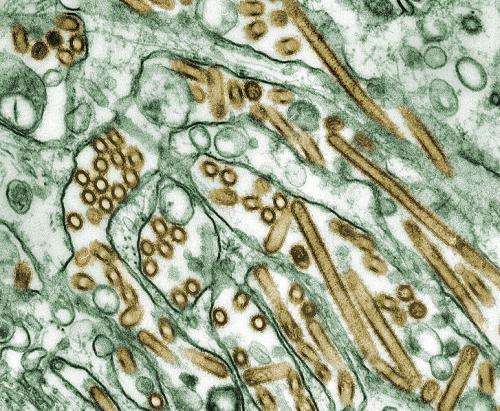May 3, 2013 report
Recent studies warn surveillance of bird flu strains is needed

(Medical Xpress)—Recent scientific papers from China suggest a vigilant watch should be kept on the development of bird flu viruses, as a new strain has been identified and previously known viruses have been shown capable of mutating to forms that could spread from human to human via respiratory droplets.
The bird flu influenza virus is made up of only eight segments of RNA. One segment codes for the hemagglutinin (HA) protein, which plays an important role in helping the virus to enter host cells, while another codes for neuraminidase (NA), which helps in the release of the virus from infected cells. HA has 17 known sub-types and NA has 10, leading to a classification of bird flu viruses as HxNy.
In a study published in the Lancet1, scientists in China looked at the genetics of a new strain of avian influenza virus, H7N9, which has infected over 80 people and killed at least 17 in China since it was identified in March 2013. The research team compared the genome of all eight segments of the H7N9 RNA to genetic data available in global virus databases, and found that the new virus could have evolved from four or more avian flu viruses occurring in ducks, migratory birds, and chickens. They suggest the HA segments probably originated in migratory birds following the East Asian fly way, the NA segments were most likely transferred to ducks in China from birds migrating from Europe, and the remaining segments appear to have their origins in H9N2 viruses found in chickens and ducks in eastern China.
The researchers also found that the virus has already mutated into two different strains.
The H7N9 virus is currently spread only from bird to bird and from bird to humans, but no human to human transmission has so far been seen. The researchers suggest that surveillance is important in humans, chickens, ducks, and wild birds because the virus could mutate into more virulent or infective forms.
A second study2 looked at the avian H5N1 influenza virus, which is highly pathogenic in birds. The study, led by George F. Gao and Wei Zhang of the Chinese Academy of Sciences in Beijing, determined the structure of wild and mutant strains of the virus and found a cis/trans change in the conformation of the glycosidic linkage between the virus when bound to avian or human receptors. This finding explains how the virus can acquire human receptor binding properties while retaining the avian receptor binding properties.
A third study3, also on the H5N1 virus, has shown that mutations of the virus could be transmitted via respiratory droplets in guinea pig hosts. This could be an important finding, because human seasonal flu is spread in this way. Until now the H5N1 has not been transmitted easily to humans unless they were in close contact with infected birds.
The research team, from the Chinese Academy of Agricultural Sciences at Harbin, and Gansu Agricultural University at Lanzhou, used reverse genetics techniques to create 127 reassortants of the H5N1 virus from ducks and a highly transmissible human H1N1 virus. Reassortment occurs naturally when a cell is infected by two or more strains of flu virus at the same time and RNA segments from the different strains mix, potentially forming new virus strains.
All 127 reassortants had the HA gene from H5N1, which is known to bind to avian receptors (HA in H1N1 binds to human receptors). The other seven genes were present in various combinations. Ensuring all the hybrids contained the HA from H5N1 allowed the researchers to test if flu viruses that were specific to birds could also infect mammals.
To find out, the team tested the transmissibility of each reassortant in guinea pigs and their virulence in mice. The study showed that in guinea pigs (which have both avian and mammalian receptors) several genes taken from H1N1 made eight of the reassortants transmissible via respiratory droplets. None of the hybrids killed their guinea pig hosts. In the mice, 35 of the reassortants caused death. The results suggest the avian H5N1 viruses could naturally acquire the ability to be transmitted from human to human by reassortment in "current agricultural scenarios."
The symptoms of the various strains of bird flu are similar to those of seasonal flu, but the risk of complications and death is higher. If the viruses become capable of easy human to human transmission, a pandemic becomes more likely.
More information: 1. Origin and diversity of novel avian influenza A H7N9 viruses causing human infection: phylogenetic, structural, and coalescent analyses, The Lancet, Early Online Publication, 1 May 2013. doi:10.1016/S0140-6736(13)60938-1
2. An Airborne Transmissible Avian Influenza H5 Hemagglutinin Seen at the Atomic Level, Science DOI: 10.1126/science.1236787
3. H5N1 Hybrid Viruses Bearing 2009/H1N1 Virus Genes Transmit in Guinea Pigs by Respiratory Droplet, Science DOI: 10.1126/science.1229455
© 2013 Medical Xpress













